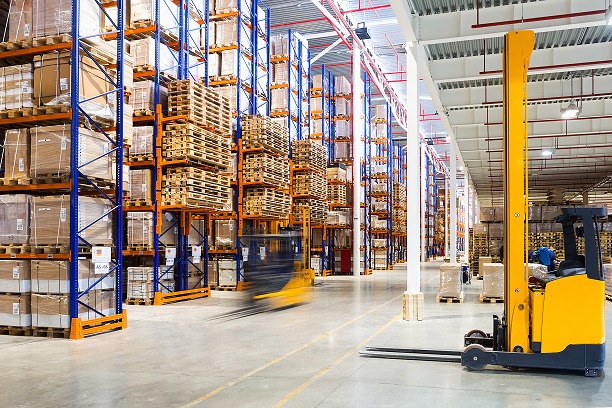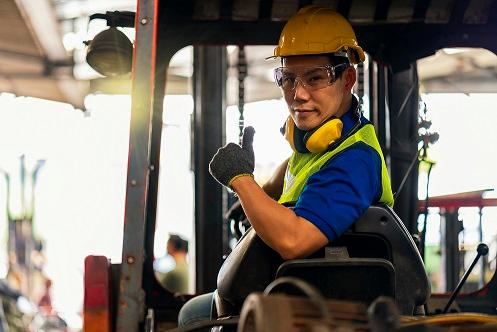Forklift incidents are a persistent safety issue for companies worldwide. Incidents can range from hitting a pedestrian, knocking off a pallet, or having a tip-over. The Occupational Health and Safety Administration (OSHA) tries its hardest to advise companies to prevent incidents and create a safety culture.
At Planet Compliance, we have compiled a list of ten steps your company can follow to help you prevent forklift incidents. Find out why it is so important for your business to avoid forklift accidents. Also, learn about the measures you can take for the safety of your workforce and business.
This article is the 4th in the latest compliance series. You can read the first three articles here:
- What are 5 Common Compliance Mistakes With Forklift Trucks
- Forklift Safety and Compliance: Benefits of Virtual Training
- The Role of Forklift Simulator Training: OSHA Standards.
Why Is It So Important To Prevent Forklift Incidents?
Forklift incidents in the workplace can damage a business in many ways. The most important issue could be a potential injury to one of your workers.
The Negative Impact of a Forklift Incident
It’s not only the possibility of an accident to an employee that can cause problems. An incorrect forklift truck operation could damage racking, machinery, or the surrounding walls. It could result in your company experiencing critical downtime.
On top of this, your company might have to pay for legal expenses and medical bills if somebody gets hurt. Finally, don’t forget about your company’s reputation. If an incident occurs, it can affect the perception of your business.
10 Steps To Follow To Prevent Forklift Incidents
You may have already set up some systems to reduce forklift incidents in your workplace. Anything you can do to avoid accidents is worth doing. Here are ten steps you can follow to protect your employees and workplace.
Provide Proper Training For Your Forklift Operators
All forklift operators must have the necessary training and certification to operate forklifts. While companies use face-to-face training, there are now more efficient and effective options. Virtual reality training is becoming the best way to train forklift operators safely.
Virtual Reality Training Can Reduce Incidents
A car manufacturer in North America followed new hires who had received virtual training, and the results were astounding. The company discovered that virtual training had reduced incidents by 30% during the first six months of employment.
A luxury goods retailer in North America also noticed a high track record of incidents in one particular shift. The company could find no reason when they looked at people’s capabilities or experience compared to other shifts in the company.
The company decided to test and retrain all the people in the shift with the high incidents. The company was amazed to find that the incident rate overall had dropped by an incredible 83%.
Work With A Reputable Trainer in Virtual Reality
Forklift Simulator, a global leader in virtual reality forklift simulator training, already helps train companies worldwide. One of their clients uses forklift simulator training in different ways. For example:
- The company can put operators in dangerous situations (e.g. losing vehicle control) to teach the employees the correct safety response.
- Recreates some of the most common incidents or uses tapes of recorded incidents. Then plays them in virtual reality for employees to experience.
- The company also has a yearly safety day. Experienced operators drive through dangerous situations and show how they would have reacted

Conduct Regular Safety Inspections
Your organization should make every effort to conduct regular safety inspections. These safety inspections can help you to identify problems and prevent accidents. It can also highlight early signs of wear and tear. Equipment can be repaired promptly or replaced.
Create A Safety Plan For Your Employees
Creating a safety plan for forklift operations is an ideal way to ensure employees do things as safely as possible. The safety plan can cover the following areas:
- Outline procedures for using forklifts
- How to maintain the forklift truck
- How to inspect a forklift
- How to conduct inspections
Regular safety training should be for all employees who work near forklifts. It ensures everybody is aware of safety protocols and how to act if an incident should occur. For example, one of Forklift Simulator’s clients puts all their warehouse pedestrians in a simulator to show them a restricted view.
Put Safety Measures In Place To Protect Your Staff From Forklift Incidents
Training, inspections, and safety plans can all help prevent forklift incidents. You can also put in place safety measures, such as:
- Barriers
- Designated lanes to separate forklift traffic from pedestrians
- Warning signs
- Awareness of hazardous situations in the workplace
- Planning and preparation to avoid hazardous situations
Enforce Safety Policies At Every Opportunity
Employees must follow the safety policies to ensure safety in the workplace. It also helps your business meet its compliance obligations. Take steps to enforce safety policies at every opportunity. Ensure employees know the consequences of violating safety guidelines and rules.
Ensure Your Forklift Operators Always Work Safely
There are many different items of safety equipment that operators can use. Make it a standard rule to do the following:
- Wear hard hats
- Use safety shoes
- Use high-visibility vests
- Have physical barriers to separate forklifts and pedestrians
- Follow traffic flow management procedures
- Use safe driving practices
- Properly use forklift attachments
- Avoid shortcuts

Limit The Speed And Focus On Load Handling
It might seem obvious, but limiting the speed can make a huge difference. It can help reduce collisions as operators have more time to react. It is also safer for employees who have to work in the same area. Also, spending time with an operator to explain how to manage a load correctly is essential.
Create Clear Communication Systems In Your Organization To Prevent Forklift Incidents
Your company must establish clear communication protocols between forklift operators and other employees. A transparent communication system ensures operators move forklift trucks safely. Without communication between forklift drivers and pedestrians, there is a high potential for an incident.
Conduct Regular Safety Training
Training should be continuous, so you can ensure you thoroughly train operators, and they are certified to operate safely. Also, conduct safety training for all employees who work close to forklifts. It helps they are aware of current safety procedures and protocols and know how to act.
Pedestrian awareness training for employees near forklifts can also help reduce incidents. For example, one of Forklift Simulator’s clients puts all their warehouse pedestrians in a simulator to show what it looks like if an operator has a restricted view.
Foster A Culture Of Safety
You can also encourage a culture of safety in your organization. It helps to keep everybody safe and promotes the company as having high safety levels. Encourage employees to report any safety hazards that they might encounter. Also, inform them that they must focus on safety in all operations in the workplace.
Start Preventing Forklift Incidents
Forklift safety needs to be a priority in the workplace. Take the initiative and put preventive measures in place to prevent potential incidents. Use modern virtual reality training and conduct regular safety inspections. Create a safety plan for your employees and conduct regular safety training.
Put safety measures in place to protect employees. Inform them of the consequences of not following safety policies. Use safety equipment and limit the speed of forklift drivers. Have a transparent communication system and foster a safety culture.
The next article in the compliance series will be 5 Key Forklift Compliance Regulations For 2023.
